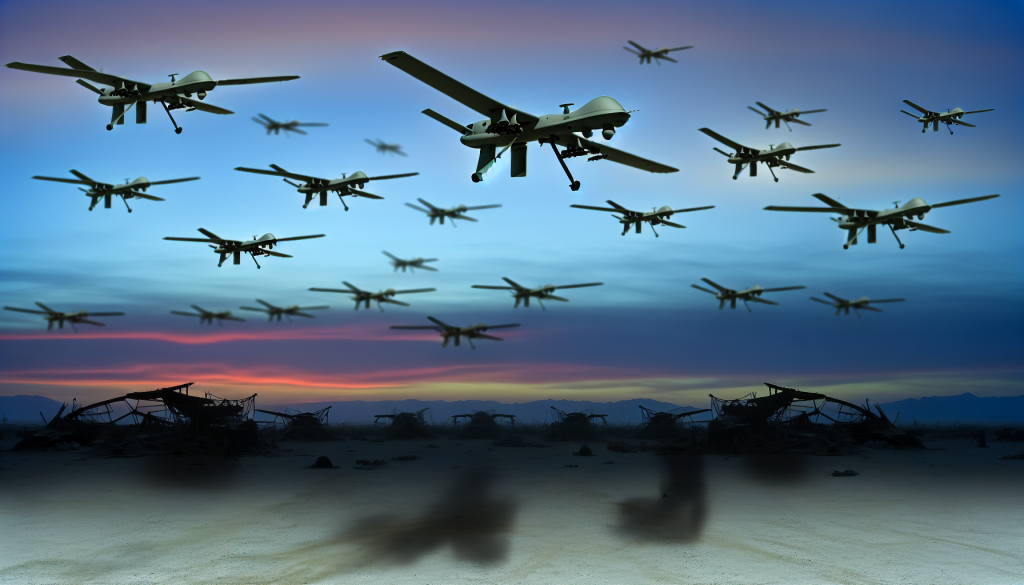The Future of Drone Warfare: The Rise of Laser Weapons
A revolutionary new-age weapon system poised to redefine drone warfare is making waves in military circles. This advanced laser technology, touted as costing mere pennies per kill, stands at the forefront of modern defense strategies. As tensions rise with nations like Russia deploying inexpensive yet lethal attack drones, experts assert that these laser systems could soon be the backbone of air defense.
The Shift in Warfare Dynamics
The current conflict between Russia and Ukraine has illuminated the critical role of drones in contemporary warfare. Drones have emerged as tools of attrition, enabling one nation to unleash swarms of cost-effective unmanned aerial vehicles (UAVs) that can overwhelm even the most sophisticated multi-million dollar air defense systems. Priced as low as $500 per unit, these flying weapons can inflict significant damage while remaining economically viable for extensive deployments.
However, intercepting these high-speed, maneuverable threats carries a hefty price tag. Conventional means of defense often involve fighter jets and expensive missiles, which can cost millions for a single shot. This unsustainable model necessitates a new approach, leading military strategists to focus on laser weaponry.
The Mechanics of Lasers in Defense
A high-energy laser weapon operates by converting electrical power into a concentrated beam of light capable of destroying its target. The idea is to establish an air-defense solution that can identify, track, and eliminate rogue drones without relying on traditional, costly interceptors.
Military experts highlight the unique benefits of this approach. James Black, Deputy Director at the RAND Europe think tank, explains that while lasers have been used in military applications for years, their deployment as a form of attack marks a significant evolution. Dr. Iain Boyd from the Centre for National Security Initiatives likens laser weapons to firearms with “infinite magazines.” As long as a power source is available, these systems can continuously fire, offering a significant tactical advantage.
Infinite Magazine Depth
The concept of “deep magazine depth”—essentially an endless supply of firepower—provides a strong defense against overwhelming assaults. Laser systems can maintain a persistent defense posture, effectively neutralizing waves of incoming drones without the logistical challenges of Ammunition supply chains.
Precision and Speed: The Laser Advantage
When a laser beam is concentrated on an object, it can disrupt, cut through, or even incapacitate it. The intense energy of the laser raises the target’s surface temperature to its melting or vaporization point within seconds. This allows for precise strikes, such as targeting a drone’s wing to cause aerodynamic failure or detonating its explosive payload.
Moreover, at lower power settings, lasers can target and blind a drone’s sensors without needing to destroy it outright. This “blinding attack” uses lower energy to overload the optics, rendering the drone ineffective. The speed at which these beams travel—at the speed of light—means there is minimal reaction time, thereby maximizing engagement efficiency.
Cost-Effectiveness
The financial implications of using lasers are staggering. Traditional air defense methods employing expensive munitions to counter inexpensive drones are unsustainable. Lasers dramatically reduce operational costs, with experts estimating that each shot may only cost a few pounds or even mere pence. Black emphasizes the necessity of more economical solutions to combat mass-produced drone threats, making laser systems an attractive alternative.
Countries worldwide are racing to develop advanced laser technologies. Israel, for instance, has successfully utilized a state-of-the-art laser system to bring down drones threatening its borders. Meanwhile, the UK’s “DragonFire,” a £140 million laser prototype, recently demonstrated its capabilities in trials, showcasing a revolutionary shift in air defense technology.
Real-World Applications
The British DragonFire system recently underwent tests in Scotland, where it managed to successfully down multiple drones with each shot costing just £10. This exceptional cost-effectiveness, paired with pin-point accuracy, could revolutionize military engagements in future conflicts.
Challenges and Drawbacks
While laser weapons exhibit groundbreaking advantages, they are not without drawbacks. There are significant concerns regarding collateral damage, particularly when it comes to the risk of blinding bystanders due to reflected beams or misfires. Dr. Boyd warns that a laser beam can travel vast distances and can reflect unpredictably off surfaces.
Weather conditions, too, pose a significant challenge. Rain, snow, fog, and mist can impair the effectiveness of laser systems, making them less reliable in certain scenarios. The tactical implications of these limitations mean that while lasers are promising, they are not infallible solutions and require careful operational protocols.
Conclusion
The emergence of laser technology in drone warfare highlights a shift towards cost-effective, precise, and rapid-response defense systems. While challenges remain, the potential for this technology to transform the battlefield is undeniable, marking a new chapter in military strategy. Countries invested in this technology may soon enjoy a distinct advantage in the ever-evolving landscape of modern warfare.

